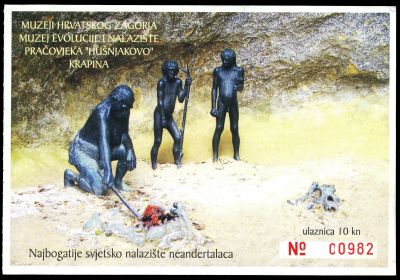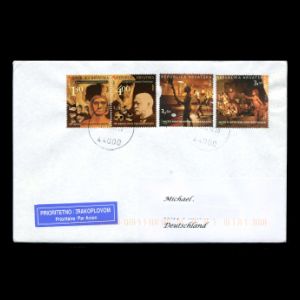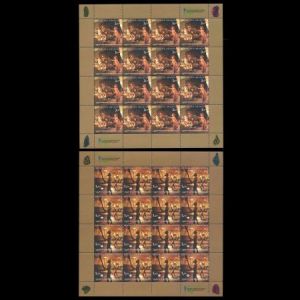Croatia 2012 "Museum of The Krapina Neanderthal Man (C)"
| <prev | back to index | next> |
| Issue Date | 07.11.2012 |
| ID | Michel: 1062-1063, Scott: 855-856, Stanley Gibbons: 1133-1134, Yvert et Tellier: 985-986, Category: An |
| Design | Zeljko Kovacic |
| Stamps in set | 2 |
| Value | HRK 3.10 - exposition of the museum HRK 1.60 - exposition of the museum |
| Emission/Type | commemorative |
| Places of issue | Zagreb |
| Size (width x height) | 35,5mm x 35,5mm |
| Layout | Two Mini Sheets of 16 stamps each |
| Products | FDC x1 |
| Paper | |
| Perforation | 14 |
| Print Technique | Offset lithography |
| Printed by | ZRINSKI dd Cakovec, Croatia |
| Quantity | 300.000 each |
| Issuing Authority | Croatian Post Inc |

On November 7th 2012, Croatian Post and Telecommunications issued the set of two stamps "Museum of The Krapina Neanderthal Man" depicting two scenes from an exhibition of the museum. Each stamp was printed in separate sheets of 16 stamps.
This is the the second stamps set issued by Croatian Post regarding the museum. The first stamps set was issued in 1999 - "100th anniversary of the discovery of the early man from Krapina". This set also consisted of two stamps.
One of these stamps shows a reconstruction of a Neanderthal female person, made by Croatian artist Rudolf Laba, made on the basis of bone remnants from the cave discovered by Dragutin Gorjanovic-Kramberger. Another stamps depicts a portrait of Dragutin Gorjanovic-Kramberger.
 |
| The entrance of Krapina Neanderthal Museum on the cachet of FDC of Croatia 2012. |
 |
| The entrance ticket of Krapina Neanderthal Museum (2013). |
Since its opening,
the Museum of the Krapina Neanderthal Man
has not ceased attracting an exceptional attention - from field experts equally as from the wide public;
already a mere number of over 100 thousand visitors in the first year of its
existence suggests the possible conclusion that the conceptual and investment
project has fulfilled its scope.
Museology practice, i.e. the intention of collecting, preserving and presentation of the remainders
of natural and cultural heritage can be performed on different interest levels and from
different interpretational aspects that are subject to change in accordance with
changes in social, ideological, aesthetic and even economic domain.
Each museum enterprise or more precisely said, the act of musealisation has the goal to archive but also
to present and as such is an expression of a particular standard of approach to material and non-material
heritage, but also - through its interpretational aspect it is a public act, and thus also a reflection of
particular contextual facts, whereby the exhibits are just the "objects of cognition".
What does the Museum of the Krapina Neanderthal Man tell us about the context, apart from, for sure,
stimulating the cognition about the natural origin of human species?
If we want to look for an answer to this question, it should be said that the context in the discussion
that follows certainly won't be reduced only to local one.
Although Jakov Radovcic and Zeljko Kovacic (the authors of the concept and entire communication project of
the Museum) make part of modern Croatian culture, here we won't dwell upon deducing particularity from
the local context reflected in the museum project, since that would, presently,
be an almost impossible mission and such evaluation should be left for some
future time, when the distance in time has done its work.
The purpose of this text is - first of all - to suggest some global, cultural, given factors that in
intellectual sense could figure as the context of emergence of this undoubtedly extraordinary project.
Intellectual attitude and cognition as one level of theorising about musealisation will be the tool for
establishing the possibility for evaluation of an interdisciplinary, scientific and artistic project by
which the anthropologic and cultural findings of the Neanderthal men have been
transformed into a simple and unique history lesson.
In simple words, the theme of the Museum is evolution - shown through global contextualisation of a local
finding.

|
| Old town of Karpina on stamp of Croatia 1993, MiNr. 223, Scott: 146A. |
In Krapina, this evolution has experienced a communications revolution as a new contribution to interpretation.
If Gorjanovic Kramberger could have ever thought that one day in far future two enthusiasts would offer
such a stratified interpretation of his findings in Hunjakovo, the least he probably would have
been able to express would be disbelief.
At that time in the 19th century when the museums - and especially Natural History Museums -
were mostly the rooms of wonders - a kind of visual fascination rather than a scientific laboratory, no
one could have dreamed about the multimedia communication level and multimedia interpretation.
Actually, the standards of musealisation were dramatically distinct from those today.
It was not due only to the development of media, but maybe - first of all, to the general philosophical
attitude towards the past, to which just the industrial modernisation gave an important contribution in
understanding the century that contained the most history than any other so far.
Hence, the fact that in Kramberger time such a presentation was not possible, is not merely technologic,
but primarily intellectual matter, since only in modern times - recently also marked as post modernism,
it has become legitimate for the museum to constitute itself as a public educational medium, and thus even
the Neanderthal man - put in interpretational context - has something to say to his modern viewer.
Products and associated philatelic items
| FDC (official) | FDC of philatelic club of Krapina | |
 |
 |
 |
| Stamp Sheets | First-Day-of-Issue Postmark | Krapina's Neanderthal on stamps of Croatia (PDF) |
 |
 |
 |

|
- Technical details and short description of the stamps:
Croatian Post (English text is short, Croatian text is more detailed), Colnect,
Acknowledgements:
Many thanks to Dr. Peter Voice, PhD Department of Geological and Environmental Sciences, Western Michigan University, USA, for review of a draft of this article.
| <prev | back to index | next> |